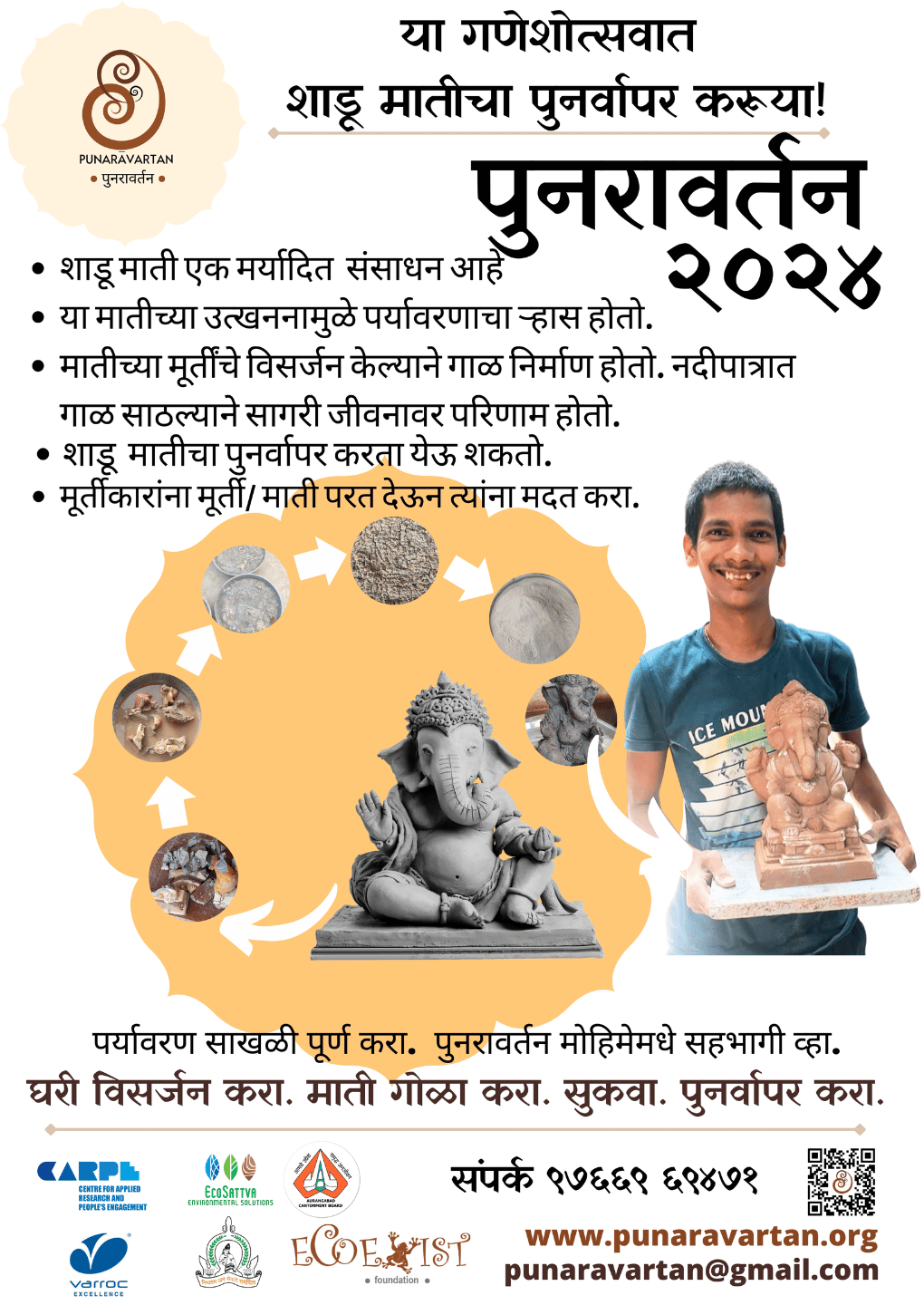CHHATRAPATI SAMBHAJINAGAR

In Chhatrapati Sambhajinagar, idol immersions take place at several locations managed by the Chhatrapati Sambhajinagar Municipal Corporation to reduce environmental impact. Key sites include artificial ponds constructed specifically for this purpose, helping to protect natural water bodies from pollution. The Gandhari River is one such location where immersions occur, with significant water quality monitoring due to the impacts of these activities (IJSRSET). Temporary collection points are also set up across the city during major festivals like Ganesh Chaturthi to facilitate eco-friendly disposal of idols (IJSRSET).
Lakes and tanks in Chhatrapati Sambhajinagar are essential for the region’s water management and historical heritage. These reservoirs, constructed over centuries by various empires, were designed for rainwater harvesting, irrigation, and domestic use. Over time, some have been repurposed for recreation, while others face challenges like pollution and encroachment. Current rejuvenation efforts include sewage treatment projects, waste management programs, and community-led conservation initiatives to restore these vital water resources.
Civic authorities conduct awareness campaigns promoting the use of eco-friendly materials for idols and encouraging the use of designated immersion sites, balancing cultural significance with environmental sustainability.
Punaravartan Posters 2024



LAKES

Lonar Lake

Harsul Lake

Salim Ali Lake
Ganpati Visarjan
Material Used


Court
The Aurangabad bench of the Bombay High Court recently disposed of a Public Interest Litigation (PIL) requesting stricter regulations on the immersion of Ganesh idols made of Plaster of Paris (PoP). The court noted that the Central Pollution Control Board (CPCB) had issued guidelines on this matter and expressed hope that the state government would implement them effectively.
The CPCB guidelines encourage the use of traditional materials like natural clay instead of PoP for making idols and recommend prohibiting the use of toxic or synthetic paints. These guidelines highlight the environmental impact of using metals, ornaments, oily substances, synthetic colors, and chemicals to decorate idols, especially during immersion.
While the CPCB guidelines do not outright ban PoP, they promote the use of clay due to its environmental friendliness. Environmental activists have welcomed this move, advocating for a return to traditional Ganpati idols and celebrations to reduce pollution and protect aquatic life. This decision by the Aurangabad bench stems from a PIL filed in 2005, along with an intervention application, requesting restrictions on the immersion of chemically painted PoP Ganpati idols in water bodies.
State asked to follow CPCB norms on PoP idols
AURANGABAD: The Aurangabad Bench of the Bombay High Court on Tuesday directed the state government to strictly follow the guidelines of the Central Pollution Control Board that has restricted immersion of Ganesh idols made from Plaster of Paris in water bodies
The directives were given in connection with a petition filed by Maharashtra Andhashraddha Nirmoolan Samiti which said that immersion of Pop idols caused water pollution
The CPCB has banned the immersion of PoP idols and had released a set of directions, which supported the ANS’s contention. The HC bench while taking these guidelines on record expected the state government and the people to follow these instructions strictly. The court also expected the state government to exert its control in the matter.
The state government needs about three years to create awareness among people and then enforce the guidelines.
REVISED GUIDELINES FOR IDOL IMMERSION
(i) As far as possible idol immersion in Rivers/Ponds/Lakes shall be encouraged only at specific designated artificial confined tanks/ponds with liner made with well graded/highly impervious clay or eco synthetic liner, on the banks shall be promoted.
(ii) A temporary artificial tank or pond with liner made with well graded/highly impervious clay or eco synthetic liner (HDPE), and having earthen bunds on the bank of the river/lake/pond shall be created for Idol Immersion by the concerned ULBs. Temporary artificial tank or pond. In case of immersion of idols in rivers, lakes or ponds is inevitable, a designated location (having proper approach, access, corner portion of a river/pond/lake, having shallow depth of water in river or lakes or ponds) should be identified and safety provision preferably steel or wooden barricades shall be made by concerned ULBs.
(iii) All the flowers, leaves and artificial ornaments of idols should be removed prior to immersion of idols and only such idols may be immersed in a designated place provided with safety provisions.
(iv) Lime or alum or any other equivalent coagulant should be added in designated temporary lined pond/tank as pre-treatment option for ensuring settling of solids. After completion of immersion, only 5.0 GUIDELINES FOR IDOL IMMERSION IN RIVERS, LAKES AND PONDS Revised Guidelines for Idol Immersion 11 supernatant water may be allowed to flow into river/pond/lake, as the case may be, after checking for colour and turbidity as per BIS specification for Drinking Water IS 10500:2012.
(v) Post immersion, with remains of idols and activities such as desludging of the designated area should be undertaken and ensured its disposal as per Solid Waste Management Rules 2016 as amended thereafter, within 24 hours by the concerned ULBs, as per these guidelines.
PARTNERS




